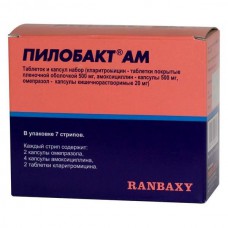Expiration date: 02/2026
The composition and form of issue:
Tablets and capsules set
Tablets, film-coated 1 tab.
clarithromycin 500 mg
other ingredients: microcrystalline cellulose povidone magnesium stearate sterinova acid talc purified silicon dioxide colloidal croscarmellose sodium
film coating: hypromellose hyprolose of propylene glycol sorbitan monooleate titanium dioxide quinoline yellow dye vanilla talc purified
composition of ink for inscription: black ink Opacode S-1-27794 (methylated alcohol IMS 74 OP, 47, 5% shellac solution in methylated alcohol IMS 74 OP, iron dye oxide black, n-butyl alcohol, propylene glycol, purified water)
Capsules 1 caps.
amoxicillin trihydrate 592, 856 mg
(corresponds to 500 mg amoxicillin)
auxiliary substances: sodium lauryl sulfate silica colloidal anhydrous croscarmellose MCC magnesium stearate
the composition of capsules:
cap: dye diamond blue dye azorubin dye quinoline yellow titanium dioxide methyl parahydroxybenzoate propylparahydroxybenzoate sodium lauryl sulfate gelatin
barrel: dye sunset yellow dye quinoline yellow titanium dioxide methyl parahydroxybenzoate parahydroxybenzoate sodium lauryl sulfate gelatin
writing ink: dehydrated alcohol butyl alcohol shellac dye iron oxide black concentrated ammonia solution propylene glycol
Enteric coated capsules 1 caps.
omeprazole 20 mg
excipients: Non Pareil Seeds (pellets from sucrose and corn starch, enteric coated tablets) lactose corn starch mannitol povidone purified talc sodium lauryl sulphate sodium hydrogen phosphate (anhydrous)
composition of intestinal-soluble membrane: hypromelose phthalate, dichloromethane*, isopropanol*, diethyl phthalate, titanium dioxide, shell of empty hard gelatin capsule size ? 2 with dark blue lid and transparent pink body
capsule shell:
cap: brilliant blue carmoisine (azorubin) gelatin methyl parahydroxybenzoate propilparagidroksibenzoat
housing: carmoisine (azorubin) gelatin methyl parahydroxybenzoate propilparagidroksibenzoat
*is lost in the production process
set of 2 tables. clarithromycin, 2 caps. omeprazole and 4 caps. amoxicillin in strip 1 set, in a pack of cardboard 7 strips.
Description of dosage form:
Clarithromycin, coated tablets: light yellow, oval, biconvex, film-coated, printed in black ink that says "SHT 500" on one side.
Amoxicillin capsules: hard gelatin, size "0 el" (the diameter of capsule cap — 7, 57-7, 71 mm, diameter capsule housing 7, 27-7, 41 mm, the length of the cap of the capsule — 11, 22-12, 30 mm, housing length capsules — 19, 70-20, 70 mm), body color yellow, lid brown color with printed black ink lettering "500" on the lid and the housing. The contents of the capsule-white or almost white granular powder / pellets.
Omeprazole capsules: solid, gelatin, with a "lock", size ?2 with a cover of dark blue color and transparent pink body, containing white or almost white spherical granules covered with an intestinal-soluble shell.
Pharmacokinetics:
All three drugs that are part of Pilobakta AM, have good absorption by oral administration.
Omeprazole is rapidly absorbed after oral administration, and its bioavailability is 30-40%. Food intake has no effect on the bioavailability of omeprazole. Cmax of the drug in plasma is achieved through 0, 5-1 h. Binding to plasma proteins is 90%. Almost completely metabolized in the liver. The main route of excretion is the urine (80%).
Clarithromycin is rapidly absorbed from the digestive tract. The absolute bioavailability of 250 mg clarithromycin is approximately 50%. Eating slightly slows down the beginning of clarithromycin absorption and the formation of 14-hydroxyclarithromycin, but does not affect bioavailability. When taking Cmax fasting in serum are reached within 2 hours after oral administration and are 0, 6 and 0, 7 µg/ml for clarithromycin and its main metabolite. T1/2 is 3-4 hours clarithromycin Clarithromycin is widely distributed in the body. The concentration of clarithromycin in the tissues exceeds that in serum. Protein binding ranges from 42 to 70%. It is excreted by the kidneys and with feces (20-30% — in unchanged form, the rest — in the form of metabolites). Simultaneous administration of clarithromycin and omeprazole improves the pharmacokinetic properties of clarithromycin: the average value of Cmax increases by 10%, the minimum concentration — by 15% compared with the same figures for monotherapy clarithromycin. The concentration of clarithromycin in the gastric mucosa while appointing it with omeprazole is also increased.
Amoxicillin is rapidly absorbed from the digestive tract. Eating does not affect the absorption of amoxicillin. The bioavailability of amoxicillin is 75-90%. The drug is quickly distributed in the tissues of the body. T1 / 2 is 1-1.5 h. protein Binding — 20%. About 60% of the dose is excreted in the urine unchanged, a small amount — with feces.
Description of the pharmacological action:
Triple therapy, including omeprazole, clarithromycin and amoxicillin, allows achieving a high percentage of Helicobacter pylori eradication (85-94%).
Omeprazole inhibits secretion of gastric acid due to specific inhibition of H+ K+ - ATPase-an enzyme located in the membranes of parietal cells of the gastric mucosa. Reduces basal and stimulated secretion regardless of the nature of the irritant. After a single reception of the drug inside action of omeprazole occurs within the first hour and continued for 24 h, the maximum effect is reached after 2 h After discontinuation of the medication secretory activity is completely restored after 3-5 days.
Clarithromycin is an antibiotic from the group of macrolides, a semi-synthetic derivative of erythromycin A. it Has an antimicrobial effect, which is associated with the suppression of protein synthesis by interacting with 50S ribosomal subunit of the microbial cell. Effective against large number of gram-positive, gram-negative aerobic and anaerobic bacteria, including N. p?lori. Formed in the body metabolite-14-hydroxyclarithromycin-also has a pronounced antimicrobial activity.
Amoxicillin-semi-synthetic penicillin, has a bactericidal effect, has a wide range of effects. Antimicrobial action is due to inhibition of synthesis of peptidoglycan (base polymer of the cell wall) during the period of division and growth. Has potent activity against N. p?lori. H. Resistance pulori to amoxicillin is rare.
The combination of amoxicillin and clarithromycin has potentiated antimicrobial effect against N. p?lori.
Indications:
Eradication therapy of H. p?lori in peptic ulcer disease of the duodenum.
Contraindications:
- hypersensitivity to omeprazole, clarithromycin or amoxicillin, as well as to antibiotics of the macrolide group
- interactions with cisapride, pimozide, astemizole and terfenadine (see "Interaction»)
- pregnancy
- breast feeding
- porphyria
- childhood
- renal or hepatic insufficiency.
Application during pregnancy and breast-feeding:
Contraindicated.
Side effect:
From digestive organs: dysbacteriosis, diarrhea or constipation, nausea, vomiting, flatulence, abdominal pain, dry mouth, taste disorders, stomatitis, transient increase in the activity of liver enzymes in plasma, impaired liver function, rarely — pseudomembranous enterocolitis.
From the nervous system: headache, dizziness, excitement, drowsiness, insomnia, ataxia, paresthesia, depression, confusion, hallucinations, epileptic reactions, peripheral neuropathy.
From the side of musculoskeletal system: muscular weakness, myalgia, arthralgia.
From the hematopoietic system: leukopenia, neutropenia, thrombocytopenia, thrombocytopenic purpura, anemia.
From the skin: itching is rare-skin rash, in some cases — photosensitization, multiform exudative erythema, alopecia.
Allergic reactions: urticaria, angioedema, bronchospasm and anaphylactic shock.
Other: tachycardia, interstitial nephritis, visual impairment, peripheral edema, increased sweating, fever, gynecomastia.
Drug interaction:
Simultaneous administration of theophylline and clarithromycin is accompanied by an increase in the concentration of theophylline.
Simultaneous administration of clarithromycin with terfinadine increases the concentration of the latter and can lead to elongation of THE Qt interval.
Simultaneous administration of clarithromycin with indirect anticoagulants can potentiate the action of the latter.
When concomitant administration with clarithromycin the levels of carbamazepine, cyclosporine, phenytoin, disopyramide, lovastatin, valproate, cisapride, pimozide, astemizole, digoxin may be increased.
Omeprazole can slow the elimination of phenytoin, diazepam, warfarin, as well as affect the absorption of ketoconazole, ampicillin and iron salts by inhibiting the secretion of acid in the stomach.
With the simultaneous appointment of amoxicillin with oral contraceptives may reduce the effect of the latter.
Method of application and doses:
Inside. Each strip containing pills and capsules set Pilobaktam, designed for one day of treatment and consists of two parts: red — with the words "morning" and blue — with the words "evening".
In the morning before meals should take the contents of the" morning " completely (one capsule of omeprazole, one tablet of clarithromycin and two capsules of amoxicillin). In the evening reception before meals should take the contents of the" evening " completely (one capsule of omeprazole, one tablet of clarithromycin and two capsules of amoxicillin).
Tablets and capsules should not be broken and chewed, they should be swallowed whole. The duration of treatment is 7 days.
Special instruction:
Before starting therapy, it is necessary to exclude the presence of a malignant process (especially with gastric ulcer), because the treatment, masking the symptoms, can delay the correct diagnosis.
With care appoint on a background of reception of medicines metabolized by the liver. In the case of a joint appointment with warfarin or other indirect anticoagulants must be controlled PV.
Cardiac history is not recommended simultaneous reception of with terfenadine, cisapride, astemizole.


